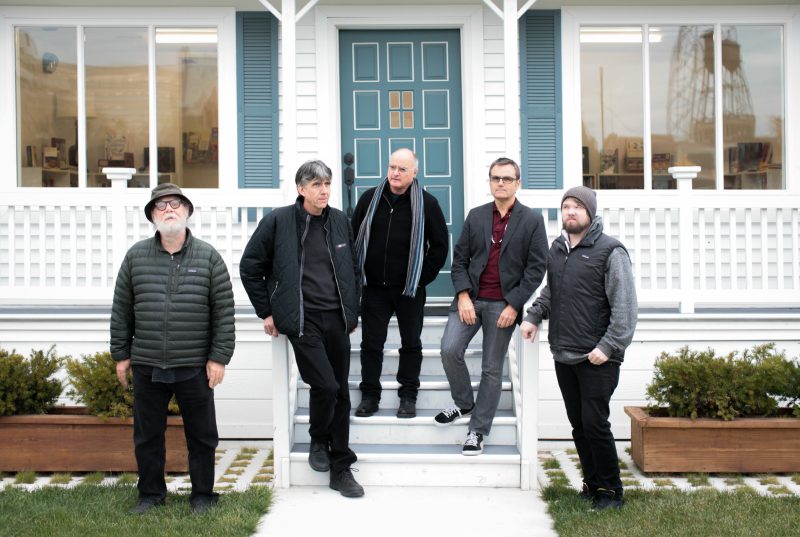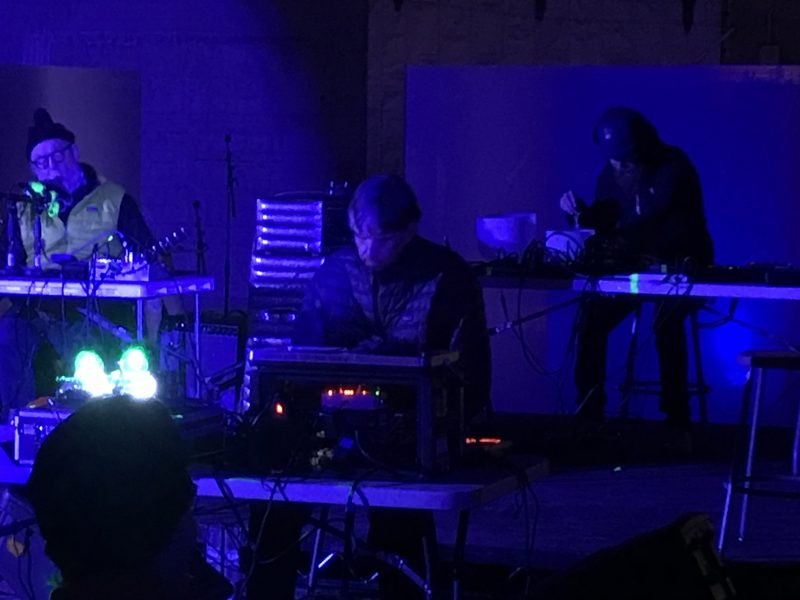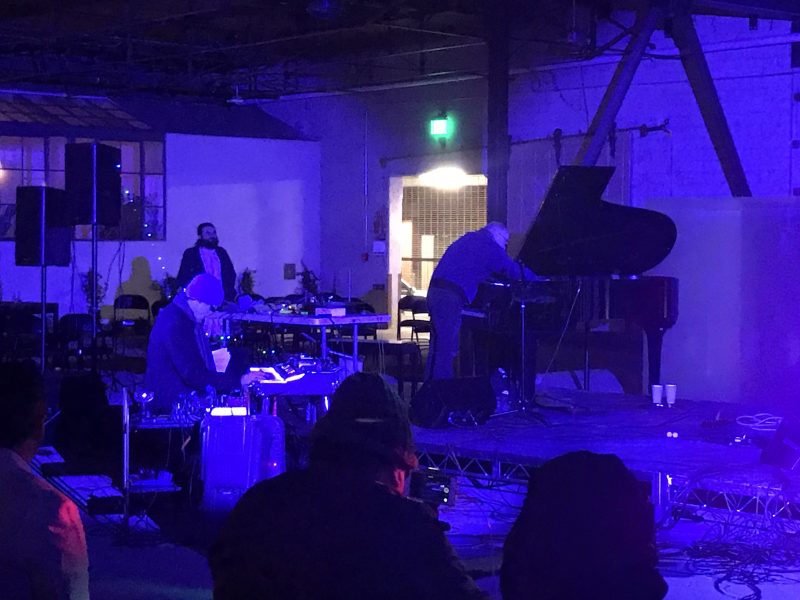
Here we are, in the windy, January night (about 50 degrees in Los Angeles — some are wearing scarves), in the wide courtyard of Hauser & Wirth, a large gallery in Downtown L.A.’s Arts District. This is the closing concert for an impressive Mike Kelley exhibit, “Kandors 1999-2011,” headlined by Extended Organ, the band that once included Kelley alongside fellow visual artist Paul McCarthy, and several founders of the L.A. Free Music Society: Tom Recchion, Joe Potts, and Fredrik Nilsen. It now features Alex Stevens in Kelley’s stead. The chill of the atmosphere gives the impression that we have all just found ourselves here, that this crowd of maybe 100 to 200 could blow away just as easily, forgetting all that is holding us in place. The crowd is mostly standing up. Telecaves and Lonely Street have played, and people surely know that Extended Organ is up next, but a third of the seats in front are empty. There is some apprehension; is that melody and drone a sound check or the faint beginning of the set? For the uninitiated (who might have seen the Mike Kelley exhibit, or the Paul McCarthy one before that, but missed all previous Extended Organ performances, and are maybe just coming around to LAFMS now), there might be even more trepidation.
What kind of extended organ is this? The “organ” in question has been played by different lineups and composed of different instruments and techniques. It continues to expand inward and outward. On this night, a howling, existential flux is the general sentiment upon which the band builds its set. It has been repeated that the late Kelley’s sounds and samples live on in Extended Organ’s recent performances, and this is just one example of how this screaming leviathan of a band eats up what is around it and just keeps screeching.
The band’s name alludes to Joe Potts’ droning instrument, the Chopped Optigan, which is a modified optical organ that continues to underlie the group’s sound.[1] The original Mattel optical organ (the Optigan), whose mechanics Potts has altered, alternately voices the concentric tracks on an optical disc to make different notes and vamping/percussion sounds. The instrument is delightfully flawed and requires constant pitch adjustment to play simple melodies and scales. Potts’ conversion of the organ allows the instrument to play as many as 64 of the disc’s tracks at once. These modifications allow for what has frequently been described as a drone-like sound, but Potts appears to have returned to the instrument over the past twenty-some years because of its versatility. This is just one of many of Potts’ homemade contraptions, but alongside his collaborators, the instrument’s wonky innovation has flourished.
Tom Recchion, Joe Potts, Fredrik Nilsen and Paul McCarthy joined forces as Extended Organ in 1995, and Mike Kelley joined a year later, after hearing the band performing at a festival in Oslo.[2] Recchion, Potts, and Nilsen had been active for 20 years as founding members of the LA Free Music Society, alongside Rick Potts, Joseph Hammer, Ace Farren Ford, Dennis “Duck” Mehaffey, Chip Chapman, Vetza and many others. Kelley and McCarthy were also intermittently involved with the LAFMS, notably in the bands Airway and CV Massage.[3] McCarthy and the LAFMS also supposedly had studios in the same Pasadena building in the 70s.[4] Onstage now, the band members don’t acknowledge one another before playing; McCarthy is poised in the back, peering inward and preparing his larynx.

As a music and art collective, the Los Angeles Free Music Society proliferated off-kilter reincarnations of what they might have called pop and rock ’n roll’s decrepit forms. Their sounds inevitably drew on L.A.’s punk rock din, as well as other distant corners of experimentation in Western music. The collective came together around shared techniques, values, and ideas, manipulating and splicing magnetic tape, hand-building instruments that might fall apart mid-performance, and exchanging the idea of virtuosity for collective improvisation. Formed in ‘95, Extended Organ is a late addition to the LAFMS canon. Their sound might be called hypnotic by some, but who can stay in a trance when you’re unsure if the vocalist is drowning, or if your speakers are blown out? Potts wanted accompaniment for the Chopped Optigan, and thus the organ in question swelled way beyond its original confines.
This concert of Extended Organ at Hauser & Wirth is special, not least because of the chance to pay homage to the late Mike Kelley, the maestro behind many of the band’s prerecorded sounds as already mentioned, as well as a multimedia art career. In its latest incarnation with Alex Stevens, Extended Organ has already performed several times, including one private performance in the tunnels beneath a homestead Kelley built at the Museum of Contemporary Art Detroit. We can only wonder how that underground show might have sounded, but I imagine in their paean a mixture of pain and tenderness not dissimilar from what begins to come through now in this set.
Tom Recchion begins the set, gently picking at the inside of a mic’ed piano. Potts’ Chopped Optigan eventually comes in, relatively quietly at first, and then McCarthy’s vocals, whining. Once the vocals have entered the soundscape, they never go away. The whines, and then howls, groans, and muttering shift over time, sometimes broken into bursts, sometimes sustained for phrases and phrases. In the background Fredrik Nilsen is playing a Rheem organ and Alex Stevens mixes in prerecorded sounds, many of which were supplied by Kelley. Lastly, one audience member in an oversized blazer and large floppy hat makes his presence known, standing next to each of the musicians in turn, and only some of us catch on that this is artist Charlemagne Palestine, in town for an installation this week.

In one standout moment, one of those tepid lounge-jazz rhythms out of Kelley’s video work plays over a vaguely melodic passage from the Optigan and elsewhere, probably from Recchion’s piano, emerges a truly terrible grinding sound. Finally, the audience can at least nod our head along with something, and yet in this same instance we find our ears under assault. We might even call this juxtaposition a bit heavy-handed, but the moment melds into the next before we can commit to doing so. In an article introducing a track from their only studio album Xoxo, Fredrik Nilsen writes of Extended Organ performances: “though there is no conscious attempt to produce any particular mood, pathos, mirth, ambivalence, menace, and exasperation are expressed, sometimes simultaneously, producing something akin to a soundtrack for a nightmare.”[5] It is hard not to think of Mike Kelley again, and how difficult it has been to sort through the emotions around the death of a friend and bandmate. Mirth, pathos, menace, and exasperation would all certainly coexist, and yet Kelley’s death is only part of the grinning hellscape that Extended Organ reflects back at us.
It does feel odd sussing out the origins of the sounds in this performance when they all build together into such an astounding final product. Alert before this organ(ism), it becomes clear that the audience is meant to leave a little unsure about what has happened and who achieved what. Rather than wear masks and churn out ego-loaded rock or electronic music, Extended Organ approaches free music from below. When asked by The Wire to define the unifying aesthetic of the LAFMS, Joe Potts simply replied: “sophomoric vituperation.” He then defined this approach as “drawing mustaches on Mona Lisas, but used as a tool, not as a goal.”[6] Extended Organ’s performances build a participatory atmosphere that absorbs and lulls us with the abject limits of instrumentation, and, depending on your mood, even sound.
By the end of this particular show, more people are sitting down, and the eager photographers have mostly joined them. Palestine has been standing contentedly in the aisle for a while now and Recchion has thrown the last of his bag of ping-pong balls into the guts of the piano. As predicted, many of us can’t figure out what we have just watched, but we feel involved and perhaps a little spooked. We can feel that this music touched another, more collective realm where mourning, disgust and awe can somehow coexist. We are together for the moment, lingering with our ears ringing, and then we quickly part ways, mostly towards cars.